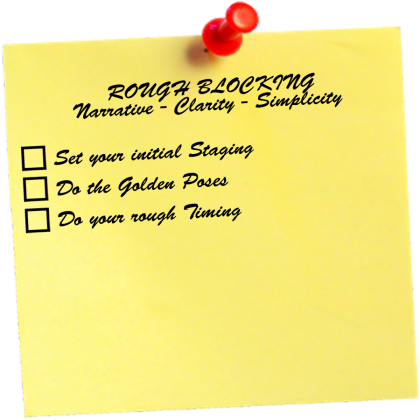Hi everybody,
To do a Rough Blocking, it only takes few steps but, from my point of view, it is the most important phase.
Once an animator told me : "The aim of the rough blocking is that even a child of 6 year old could understand it, as if it was a comic book… » (I don't know if he was refering to the directors )
Basically, you have to check that your shot is clearly understood at the first sight with a minimum of poses …One shot, one frame!
OBJECTIVE
In summary, the purpose of this phase is to search for:
• NARRATIVE
• CLARITY
• SIMPLICITY
METHODOLOGY
Those are my steps:
1. Prepare the initial staging : Place your character on the scene taking into account the geography, body's directions, eyes and general composition (hook ups) based on the information from the storyboard, the preview and the nearby shots.
2. Do the Golden Poses : As a result of your planning, cread the main narrative poses or "Golden poses" to define the choreography of your characters , marking every detail and facial and paying special attention to the composition, silhouette and line of action.
3. Do a rough timing : Place those poses on the accents (beats) defined without tuning too much (just to have your poses organized).
4. And…That's it!
CONCEPTS
Once finished, you have to ask yourself if your concepts are working :
• Intention and message : Do your Rough Blocking summarizes the intention of the director and the message and purpose of the shot? Does your shot work within the sequence?
•Character : Does the pose correspond to the personality of the character? his anatomy, his limitations?
• Action : Do we understand perfectly what the character is doing and transmitting at this moment?
•Mood : Do we understand how the character feels and what is he thinking? Are you transmitting the poses you've planned?
• Style : Do the poses corespond to the style of animation?
TOOLS
If you didn't get to thoses previous concepts, here you have a toolkit to fix it :
LAYOUT or STAGING
From the information you get:
•Hook up : Have you checked the hook ups (hook ups)?
•Body Direction : Have you checked the direction of the body?
•Eye direction : Have you checked the direction of eyes?
•Aspect Ratio : Have you checked the aspect ratio of the image?
• Position : Have you checked the position of the character on stage?
COMPOSITION
The information you get from your planning:
•Clarity & Simplicity : Have you composed your shot to read the movement simply and clearly?
•Focal Point : Have you checked the focal points and what the viewer is looking at?
•Negative Space : Have you checked the negative spaces?
•Composition : Have you checked the elements of composition : lines, volumes, texture, illusion of space?
• Framing : Have you checked the relationship between the framing and the other objects?
•Choreography : You have worked the position of the characters and used their actings to reinforce the relationship between them?
POSE (See POSE)
•Forces : Have you found the power centers and the external forces and transmited through the line of action the intention of the character?
•Physicality : Have you checked the body dynamic and marked the angles of the torso and shoulders depending on the weight, balance and fulcrums?
•Design : Have you maintained a harmony in the pose, avoiding twinning, tangents?, in other words : Do your pose have appeal?
•Contrast : Have you worked on the silhouettes and negative spaces in order to have clear and simple poses?
•Exaggerate : Have you exaggerated enough your poses, tweaking if necessary, using squash & strech?
• Entertainment : Did you use all the parts of the character to transmit your intention?
TIPS & TRICKS
• At the beginning of my rough blocking, I create a key every 5 frame, which allows me to get rid of the timing and concentrate only the poses.
• I like to work in this stage with the curves on Step mode and marking key to all drivers of the character (Full Key).
• When you are working with multiple characters, try to mark full key on the same frame to maintain my clean blocking, especially when 2 characters interact.
• Background characters can have keys with a different timing from the moment they are not distracting.
• I avoid putting constraints unless I have a clear idea of how I will work or if it is necessary.
• I work my arms in FK to be sure that the pose is well constructed.
I hope that was usefull…
Keep animating!!!



3 comments “STAGING or How to make a Rough Blocking?”